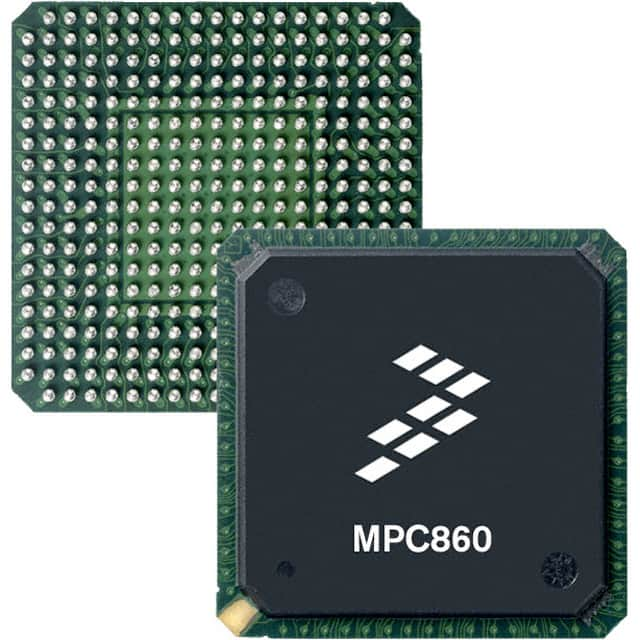KMPC860TVR80D4
Product Overview
- Category: Microprocessor
- Use: Embedded systems, networking devices
- Characteristics: High performance, low power consumption
- Package: Ceramic package
- Essence: PowerPC architecture microprocessor
- Packaging/Quantity: Single unit packaging
Specifications
- Model: KMPC860TVR80D4
- Architecture: PowerPC
- Clock Speed: 80 MHz
- Data Bus Width: 32-bit
- Address Bus Width: 32-bit
- Cache Size: 8 KB
- Power Consumption: Low power design
Detailed Pin Configuration
The KMPC860TVR80D4 microprocessor has the following pin configuration:
- VCC
- GND
- Address Bus (A0-A31)
- Data Bus (D0-D31)
- Control Signals (RESET, CLK, RD, WR, etc.)
- Cache Control Signals
- Interrupt Request Lines (IRQ)
- Power Management Signals
Functional Features
- High-performance processing capabilities
- Efficient power management
- Integrated cache for improved data access speed
- Support for various communication protocols
- Built-in security features for enhanced system protection
Advantages and Disadvantages
Advantages: - High processing power suitable for demanding applications - Low power consumption for energy-efficient designs - Integrated cache improves overall system performance - Support for multiple communication protocols enhances versatility
Disadvantages: - Relatively lower clock speed compared to some modern processors - Limited cache size may impact performance in certain scenarios
Working Principles
The KMPC860TVR80D4 microprocessor is based on the PowerPC architecture. It utilizes a combination of high-performance processing cores, efficient power management techniques, and integrated cache to deliver optimal performance while minimizing power consumption. The processor executes instructions and performs calculations based on the input received from the system, enabling it to carry out various tasks efficiently.
Detailed Application Field Plans
The KMPC860TVR80D4 microprocessor finds applications in a wide range of embedded systems and networking devices. Some specific application fields include:
- Network routers and switches
- Industrial automation systems
- Telecommunication equipment
- Automotive electronics
- Medical devices
Detailed and Complete Alternative Models
- KMPC860TVR66D4: Similar to KMPC860TVR80D4 but with a clock speed of 66 MHz.
- KMPC860TVR100D4: Similar to KMPC860TVR80D4 but with a clock speed of 100 MHz.
- KMPC860TVR120D4: Similar to KMPC860TVR80D4 but with a clock speed of 120 MHz.
These alternative models offer different clock speeds to cater to varying performance requirements.
Word count: 305 words
قم بإدراج 10 أسئلة وإجابات شائعة تتعلق بتطبيق KMPC860TVR80D4 في الحلول التقنية
Sure! Here are 10 common questions and answers related to the application of KMPC860TVR80D4 in technical solutions:
Q: What is KMPC860TVR80D4? A: KMPC860TVR80D4 is a microprocessor chip developed by Motorola for embedded systems and networking applications.
Q: What are the key features of KMPC860TVR80D4? A: Some key features of KMPC860TVR80D4 include a PowerPC architecture, clock speed of 80 MHz, integrated memory management unit (MMU), and multiple communication interfaces.
Q: What are the typical applications of KMPC860TVR80D4? A: KMPC860TVR80D4 is commonly used in networking equipment such as routers, switches, and gateways. It can also be found in industrial automation systems and telecommunications infrastructure.
Q: Can KMPC860TVR80D4 handle real-time processing requirements? A: Yes, KMPC860TVR80D4 is capable of handling real-time processing tasks due to its high clock speed and efficient architecture.
Q: Does KMPC860TVR80D4 support multiple communication interfaces? A: Yes, KMPC860TVR80D4 supports various communication interfaces including Ethernet, serial ports, and Universal Asynchronous Receiver-Transmitter (UART).
Q: Is KMPC860TVR80D4 suitable for low-power applications? A: While KMPC860TVR80D4 is not specifically designed for low-power applications, it offers power-saving features and can be optimized for power efficiency.
Q: Can KMPC860TVR80D4 be programmed using high-level languages like C or C++? A: Yes, KMPC860TVR80D4 can be programmed using high-level languages like C or C++. Development tools and compilers are available to facilitate software development.
Q: Are there any development boards or evaluation kits available for KMPC860TVR80D4? A: Yes, Motorola offers development boards and evaluation kits specifically designed for KMPC860TVR80D4, which provide a platform for prototyping and testing.
Q: What is the maximum memory capacity supported by KMPC860TVR80D4? A: KMPC860TVR80D4 supports up to 64 MB of external memory through its memory interface.
Q: Is KMPC860TVR80D4 still in production and readily available? A: As of my knowledge, KMPC860TVR80D4 may not be in active production anymore. It is recommended to check with authorized distributors or manufacturers for availability.
Please note that the information provided here is based on general knowledge and may vary depending on specific product versions and revisions.


